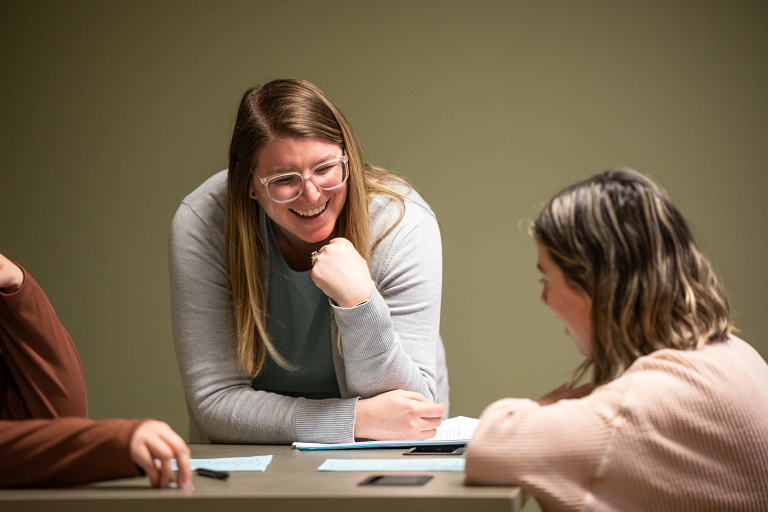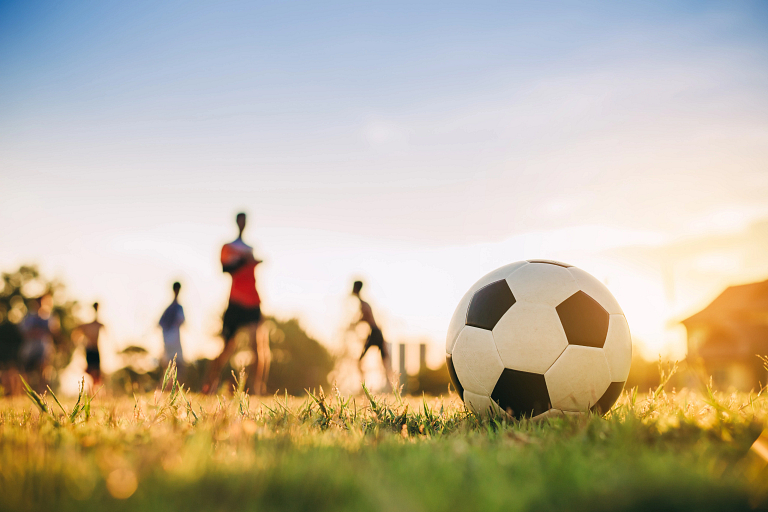As a clinical assistant professor at Indiana University South Bend -- as well as a certified athletic trainer with the Beacon Health System in South Bend -- Jennifer Deranek is used to straddling the line between the lecture hall and the athletic field.
 View print quality image
View print quality image
In fact, it's not uncommon for the IU South Bend School of Applied Health Sciences faculty member to encounter the same students in her classroom as she does on the playing field. In her clinical role, Deranek regularly provides sideline medical care to college students and young athletes in a variety of sports, such as soccer, lacrosse and football, across the community.
It's a position that also provides a deep perspective on the topic of concussions since she's familiar with the condition both as a health educator and a professional who's helped provide care to dozens -- if not hundreds -- of young people after they've experienced a concussion playing their sport. Although she's seen many in her career, Deranek said enough concussions are unreported that the Centers for Disease Control and Prevention has described them as "a silent epidemic."
Based upon these experiences, Deranek said there are some key points that everyone should know about concussions, especially the parents of younger athletes, who are sometimes overeager to get back on the field and rejoin their teammates after an injury.
What is a concussion?
A concussion is a traumatic brain injury in which a blow to the head causes the brain to move rapidly back and forth, striking the sides of the skull. People can experience concussions in many types of sports, Deranek said -- not just football.
Soccer, diving and cheerleading are some of the sports with the greatest risk of concussion. Household activities, car accidents, domestic violence and slip-and-fall accidents can also result in concussions.
How common are concussions?
It's estimated that 300,000 to 3.8 million people in the U.S. experience a concussion each year. The numbers vary so widely because most injuries remain unreported, Deranek said, noting that anywhere from 30 to 50 percent of concussions are unreported -- and untreated.
What are the symptoms of concussion?
One of the biggest challenges is that individuals' symptoms vary greatly. Deranek said people may not show signs of concussion for hours or days after a head impact.
Among the many potential symptoms of concussion are dizziness, ringing ears, sensitivity to lights or sounds, confusion, difficulty concentrating, headaches or vomiting. Short- or long-term memory loss can also occur after a concussion.
What are the long-term effects of concussion?
The potential long-term effects of concussion include difficulty focusing, difficulty with task management and time management, and other activities associated with executive functioning. It's estimated that concussions increase an individuals' lifetime risk for dementia by 72 percent; Parkinson's disease by 57 percent; and ADHD by 39 percent.
These numbers should not be taken lightly, Deranek said. She said proper management can ensure an injury that occurs in a moment won't likely lead to long-lasting effects. She also cautions that multiple concussions over time can have compounding long-lasting effects, especially when untreated.
 View print quality image
View print quality image
How long does it take to recover from a concussion?
The delay in symptoms is why testing over a period of time is a key to a strong recovery, Deranek said. It's not enough to assess for concussion immediately after an event.
Parents and athletes need to know that follow-up assessments are an important part of the process, even if they require multiple trips to see a medical provider in the days and weeks after an injury. Everyone's injury is unique -- not only in terms of symptoms but also in terms of the nature of the impact and other health factors that may or may not aid in the recovery process.
What are "concussion protocols," and why are they important?
Deranek said medical professionals will present athletes who've experienced concussions with a "return-to-play" protocol, or a series of steps through which the player can safely return to their sport. This protocol might start out with mental and physical rest -- no school work, no stimulating television, no reading -- and then slowly ramp up activity based upon continued assessment for symptoms such as headaches or dizziness.
Although this approach is now common in the world of sports, Deranek said it's important that schools and workplaces also adopt "return-to-learn" and "return-to-work" protocols for students and workers who experience concussions, since the ability to safely recover requires flexibility in these environments as well.
What is biggest challenge regarding concussions?
The greatest challenge related to concussions isn't so much a lack of research but rather a lack of widespread understanding of their seriousness, Deranek said. Although new studies regularly emerge about the dangers of untreated concussions, it remains difficult for many athletes to resist the urge to play down the seriousness of their injuries due to fear of being removed from the game, especially among young people for whom sports are a source of identity. Many players are fearful that removal from their sport for several days or weeks -- or longer -- will harm their completive edge or isolate them from their peers, Deranek said.
What can parents, coaches and athletes do?
These challenges underscore the importance of trust and compassion in the relationship between parents, athletes, medical professionals, athletic trainers and coaches, Deranek said. It's important that individuals who experience concussions -- as well as their caregivers and coaches -- realize the seriousness of the injury so they will choose to protect themselves from long-term harm.
It's also important that health professionals acknowledge the emotional nature of decisions about removal from play. And it's important that institutions -- sports teams, schools and workplaces -- understand that people who experience concussions require space and flexibility to adapt and heal.
